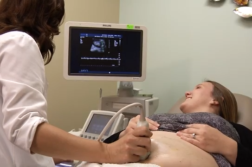PITTSBURGH, Pa. (Ivanhoe Newswire) — Pregnancy complications like pre-eclampsia and gestational diabetes can begin without warning. Often, women will have no symptoms, but these are conditions that can create long-lasting health problems for both mother and baby. Some providers are using a first-of-its kind monitoring system for moms at high risk.
Skylar Andrews was in perfect health when she became pregnant with her son Zayn. But toward the end of her pregnancy, Andrew’s blood pressure skyrocketed.
“About 200 over 114,” Andrews said.
Andrews had a condition called pre-eclampsia, dangerous for mom during pregnancy and after.
Hyagriv Simhan, MD, Director of Maternal-Fetal Medicine at Magee-Womens Hospital said, “It increases the risk of heart attack and stroke over the lifetime about two and a half fold.”
That’s why doctors encouraged Andrews to check herself at home. With this portable cuff and a smartphone, she could. Thirty-eight-year-old Jessica Wolfe also needed high-tech support. After years of battling infertility, this was a big surprise.
“We still struggle with wow this is real. This is happening. We’re gonna have a baby,” Wolfe said.
Wolfe is considered higher risk. She has gestational diabetes.
An app on Wolfe’s smartphone generates reminders to check her blood sugar four times a day and report back so doctors can respond.
“We want to be able to identify the patients who need a phone call and not just identify them when they show up in the emergency department,” Dr. Simhan said.
Andrew’s blood pressure is now back to normal. Two conditions made a little more manageable with the touch of a button.
Dr. Simham says the remote monitoring program also helps with compliance after pregnancy. Only about 40 percent of all women keep their post-partum appointments after they deliver. Ninety percent of the women who were enrolled in the remote monitoring program during pregnancy keep their appointments. Go to www.goodbyefibroids.com for more information.
Contributors to this news report include: Cyndy McGrath, Supervising and Field Producer; Hayley Hudson, Assistant Producer; Roque Correa, Editor; Kirk Manson, Videographer.
Free weekly e-mail on Medical Breakthroughs from Ivanhoe. To sign up: http://www.ivanhoe.com/ftk
MEDICAL BREAKTHROUGHS
RESEARCH SUMMARY
TOPIC: HIGH RISK PREGNANCY MONITORING
REPORT: MB #4568
PREECLAMPSIA: Preeclampsia is a serious blood pressure condition that can happen after the 20th week of pregnancy or after giving birth (called postpartum preeclampsia). It’s when a woman has high blood pressure and some of her organs, like her kidneys and liver, may not be working normally. Blood pressure is the force of blood that pushes against the walls of your arteries. Preeclampsia is a serious health problem for pregnant women around the world. It affects two to eight percent of pregnancies worldwide. In the United States, it’s the cause of 15 percent of premature births. Signs and symptoms of preeclampsia include changes in vision, headache, nausea, pain in the upper right belly area or in the shoulder, sudden weight gain, swelling in the legs, hands or face and trouble breathing.
(Source: https://www.marchofdimes.org/complications/preeclampsia.aspx)
GESTATIONAL DIABETES: Gestational diabetes is a type of diabetes that is first seen in a pregnant woman who did not have diabetes before she was pregnant. Some women have more than one pregnancy affected by gestational diabetes. Gestational diabetes usually shows up in the middle of pregnancy. Doctors most often test for it between 24 and 28 weeks of pregnancy. Often gestational diabetes can be controlled through eating healthy foods and regular exercise. Sometimes a woman with gestational diabetes must also take insulin.
(Source: https://www.cdc.gov/pregnancy/diabetes-gestational.html)
NEW TECHNOLOGY: Patients are sometimes sent home on new medications or continuing to take a medication they were prescribed during the pregnancy related to hypertension diagnosis. These patients are given instructions and education regarding signs and symptoms that would alert them to call their OB or come back to the emergency department. It has not been a standard of care to ask this population of patients to check their blood pressure regularly and report it back during the weeks following a delivery. Patients experiencing and needing treatment for a hypertensive crisis is the most common reason for readmission to UPMC Magee-Womens Hospital. The University of Pittsburgh Medical Center has been an innovator in the use of remote patient monitoring technology. By reaching patients where they are, using familiar consumer electronics paired with common health peripherals such as blood pressure cuffs and scales, UPMC has dramatically improved patient engagement, reduced emergency department visits, and decreased the number of hospital readmissions for chronically ill patients.
FOR MORE INFORMATION ON THIS REPORT, PLEASE CONTACT:
Madison Brunner, UPMC
412-432-8390
If this story or any other Ivanhoe story has impacted your life or prompted you or someone you know to seek or change treatments, please let us know by contacting Marjorie Bekaert Thomas at mthomas@ivanhoe.com




